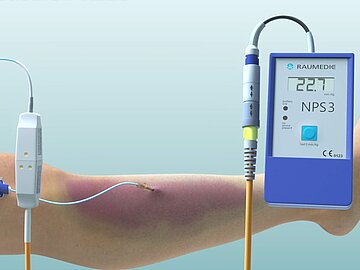It seems you’re visiting from the United States.
Please note that the offering shown on this page is not available in your country.

Early detection of compartment syndrome Intramuscular Tissue Pressure (IMP) Measuring Catheter
Compartment pressure measuring is vital as it detects dangerous increases in muscle pressure. Timely assessment prevents tissue damage, ensuring proper treatment and averting potential complications.
The OMNIBAR E5F by RAUMEDIC is a measuring catheter for trauma care, providing precise pressure measurements for early detection of compartment syndrome. It’s a sterile catheter designed to measure the pressure inside a muscle compartment. This measurement is crucial in diagnosing and managing compartment syndrome, a condition characterized by increased pressure within a muscle compartment that can lead to muscle and nerve damage.
How does the compartment pressure measurement from RAUMEDIC work?
- The OMNIBAR E5F catheter is positioned in the muscle compartment - with the help of an application tool 14G
- It is connected to a pressure monitoring device (NPS3) via an extension cable (ICP-TEMP-Cable)
- After being connected, it immediately displays pressure values on the NPS3

Advantages of the Compartment Pressure Measurement with RAUMEDIC:
- Sterile pressure measurement catheter complies with hygienic requirements
- Plug & Play system – no catheter calibration necessary
- Simple and precise compartment pressure measurement thanks to microchip technology
- Steady and artefact free measurement
- No pressure increase caused by additional fluids in the compartments
- Reliable display of the measurements
Intramuscular Tissue Pressure Measuring (IMP) Catheter OMNIBAR E5F
The sterile catheter OMNIBAR E5F measures the pressure inside the compartment at rest, during a stress test and after the stress test. The difference in these 3 pressures can confirm the diagnosis. The device is designed to provide steady, artifact-free measurements without causing additional pressure increase in the compartment due to fluids.
Technical Data:
- Outside diameter: 5F
- Catheter length: 55 cm
- Material: PU
Different Possible Set Ups for Pressure Measurement:
Portable pressure measurement
The battery operated NPS3 device in connection with a ICP-TEMP-Cable, which serves as an extension cable
Long-term measurements
For long-term measurements: One end of the NPS2 connects directly to the patient monitor and the other end is connected to the ICP-TEMP-Cable (extension cable)
Flyer
Compartment Pressure Measurement
Intracompartment Pressure Measurement is the safest way for an early diagnosis of Compartment Syndrome.
FAQ
Compartment Syndrome is a painful buildup of pressure around the muscles. The high pressure in the compartment impedes blood circulation to and from affected tissue and can cause severe tissue damage.
There are many types of Compartment Syndrome like: fractures, leg vein thrombosis, ruptures of a muscle fiber, strain traumas and contusions, congestions, compression of soft tissues.
Increased pressure within a muscle compartment in compartment syndrome can impede blood flow to the muscles and nerves. This diminished blood flow can lead to tissue damage and, if left untreated, may result in long-term complications, including nerve and muscle dysfunction.
Yes, the OMNIBAR E5F catheter can be applied to measure Intramuscular Pressure (IMP). Its design and technology allow for accurate and reliable measurements without causing additional pressure increase in the muscle compartment due to fluids.
Yes, the OMNIBAR E5F catheter can be connected to the battery-powered pressure display device NPS3 via an extension cable, allowing for a comprehensive and integrated approach to compartment pressure monitoring.
Yes. Chronic Compartment Syndrome is a condition that can develop from repetitive, strenuous exercise, causing increased pressure and reduced blood flow.
Did we spark your interest? Get in touch
Medical Product Documents
Discover our collection of crucial medical documents, from product instructions to essential certificates for our medical products.